
For legal reasons that's a joke: how memes bolstered YouTube's biggest subscription competition
If you were active on any social media platform in late 2018 to 2019, you may have encountered memes and news about the PewDiePie vs. T-Series subscription competition that transcended internet culture and wormed its way into offline culture. This marked the beginning of the acknowledgement that big corporations had dethroned internet celebrities in popularity on YouTube and showcased the efficiency of meme marketing.
As it is, Garcia Rapp and Roca-Cuberes (2017) and Cunningham and Craig (2017) agree on the fact that authenticity—which is expected from PewDiePie as an influencer and independent creator—is crucial to an influencer’s success. However, PewDiePie is still expected to be worthy of emulation while being relatable, which allows him to appear larger than life while still being an independent creator that engages with his followers. The distinction between PewDiePie being an independent creator and T-Series being a corporation will be displayed to demonstrate the importance of authenticity to online acclaim.
Furthermore, memes and meme marketing are an integral part of internet culture. Shifman (2013) uses a communication-oriented angle to explain the behaviour of people when they make and share memes, which is integral to meme marketing and the culmination of a collective online cultural experience. She rejects the idea that memes are simple concepts that spread on the internet like a virus and states that major events—in this case, the competition—trigger their inception. The extent to which memes boost an influencer’s popularity and how influencers use meme marketing to their advantage will be discussed along with the conflict and the subsequent reactions to it to display the vital role of memes in influencer culture.
As influencers have an alternative culture in the way they present themselves to their content consumer compared to traditional media figures, more focus will be on PewDiePie because his role as an influencer is vital to this article’s synthesis.
Choose your fighter
Felix Kjellberg, AKA PewDiePie, is a Swedish YouTuber known for his gaming videos and comedic reaction videos. He created his YouTube channel in 2010 and currently holds the record for being the most subscribed-to independent creator on the website with 108 million subscribers (Social Blade).
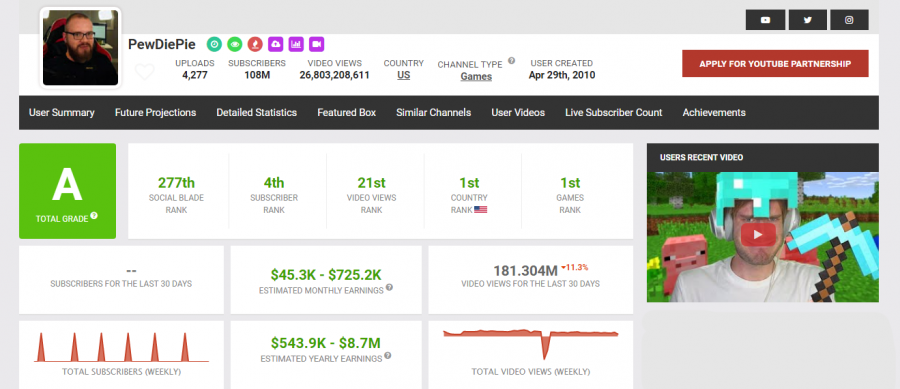
Figure 1: PewDiePie Youtube statistics as of 2020
T-Series is an Indian record label and production company known for their Bollywood and pop songs. The company was founded in 1983 and their YouTube channel, which currently holds the record for being the most subscribed-to channel at 167 million subscribers, was created in 2006 (Social Blade).
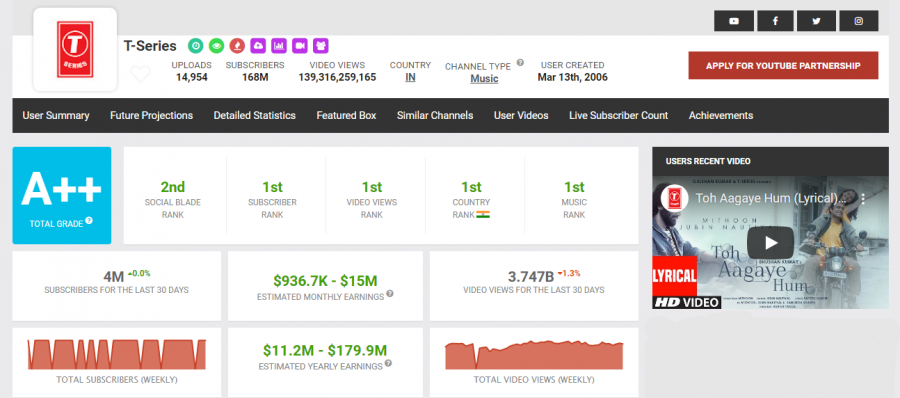
Figure 2: T-Series YouTube statistics as of 2020
The Great Subscriber War
What the PewDiePie fanbase had dubbed the Great Subscriber War started on 29 August 2018 when T-Series’ subscriber count neared PewDiePie’s. PewDiePie (jokingly) rallied his subscribers against the company in his video “THIS CHANNEL WILL OVERTAKE PEWDIEPIE!” after being informed of the subscriber count. Soon after, several YouTubers, such as MrBeast, Jacksepticeye, and Logan Paul, started showing their support for PewDiePie through buying billboards, livestreaming, and tweeting about the competition. The support made its way into offline culture when MrBeast and his friends attended the Super Bowl in shirts that read “Sub 2 PewDiePie”.
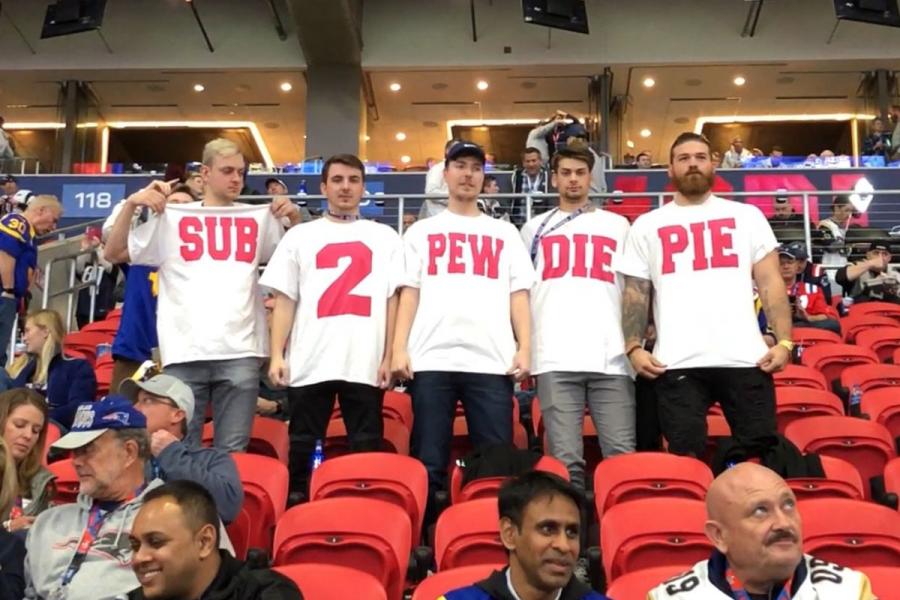
Figure 3: Photo of MrBeast and his friends wearing “Sub 2 PewDiePie” shirts to the Super Bowl
Furthermore, articles were written about how T-Series surpassing PewDiePie could mean the end of “the golden age of YouTube” and the start of corporatisation of the platform. According to Stokel-Walker (2020), this brings an indication that success on YouTube may call for “industrialized mass production” as T-Series does, considering the fact that the company has 30 separate channels that focus on diverse niches and languages.
As with any major event, controversy followed. PewDiePie had released his first diss track on T-Series, which was filled with lyrics mocking the corporation and Indian stereotypes. Following its release, T-Series filed a cease and desist document, stating that “Bitch Lasagna” was defamatory (Alexander, 2019a), while some people claimed that the lyrics were racist. However, in an Asian Boss video, many Indians who were interviewed actually stated that they didn’t find the videos racist.
PewDiePie eventually called for a stop to the meme on 28 April 2019 (Alexander, 2019c) along with the YouTubers who supported him. He asked his subscribers to stop harassing T-Series with the “Subscribe to PewDiePie” meme and stated that “it started out of love and support, so let’s end it with that.” PewDiePie also addressed the Christchurch shooting, in which the shooter said “Subscribe to PewDiePie” while livestreaming the attack (Roose, 2020), stating that “I didn't want hate to win ... But it's clear to me now the 'Subscribe to PewDiePie' movement should have ended then.”
YouTube and the issue of authenticity
PewDiePie is, by all accounts, a paragon of a social media influencer. As authenticity is now a quality expected from a social media entertainer, PewDiePie follows the norms García Rapp and Roca-Cuberes (2017) use as criteria for what makes an influencer authentic; he is relatable, often telling stories of incidents he finds himself in that his audience could relate to, yet he gives off the aura of someone who is worthy of emulation; he manages his content to be consumer-friendly and he tries to be consistent with his upload schedule; and he, most importantly, maintains community ties with his viewers.
many independent creators on YouTube showed their support for PewDiePie and shared their distaste towards the corporatisation of the platform
According to Cunningham and Craig (2017), authenticity is determined in a back-and-forth relationship with an influencer's audience. We can see that, by participating in the "Subscribe to PewDiePie" meme, PewDiePie is reinforcing his authenticity as an influencer, and by interacting with his audience for feedback, he is able to tailor the content he produces to pander to the masses, earning him more subscribers.
T-Series, on the other hand, cannot be considered an influencer due to the fact that it is a big, traditional company. While being a company doesn't immediately negate being an influencer, T-Series lacks the second defining characteristic Cunningham and Craig (2017) and Gracía Rapp and Roca-Cuberes (2017) look for in an influencer, which is the real-time relationship between influencer and audience. Being a music and production company, T-Series already has a plethora of content ready to be released and consumed without having to receive feedback from their fans. With the lack of a "call-and-response rhetorical field" (Cunningham and Craig, 2017), T-Series cannot make a claim to authenticity as an online influencer would.
As aforementioned, many independent creators on YouTube showed their support for PewDiePie and shared their distaste towards the corporatisation of the platform (Alexander, 2019b). Besides the faulty YouTube algorithm costing YouTubers viewers (Alexander, 2019b), they also started sharing the platform and revenue with big companies, like T-Series, who decided to profit off of online streaming and now have the most subscribers on YouTube (Parker, 2019). PewDiePie spoke out about it, saying “…I think if YouTube does shift in a way where it does feel more corporate, [then] something else will take its place. I think people enjoy this connection so much, I think something else will just show up, if it feels too corporate.”
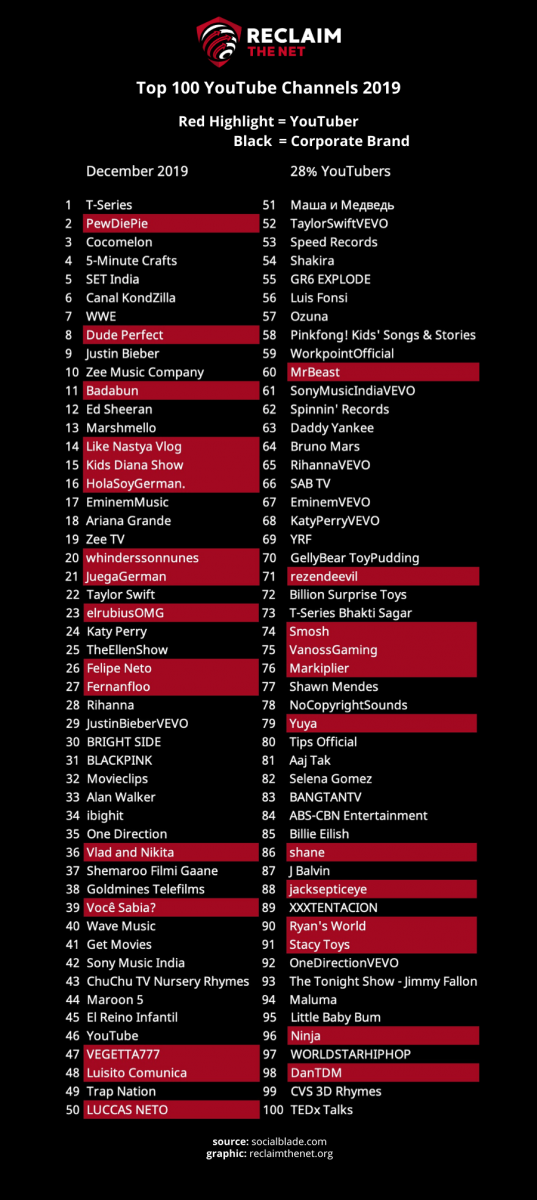
Figure 4: List of the top 100 most subscribed YouTube channels in December 2019
Additionally, PewDiePie supporters reason that it's more important to support an independent creator instead of a multimillion-dollar company, such as T-Series, that makes its profits outside of YouTube. However, PewDiePie earns $573,000-$9M annually from revenue streams (Social Blade), which isn’t a small amount of money. According to Cunningham and Craig (2017), he also profits from merchandising and appearances. While this fact doesn’t discredit the need to support independent creators or his authenticity, it does show that PewDiePie doesn’t need additional subscribers to live life comfortably.
The role of memes
In regards to memes, Shifman (2013) defines them as units of culture that are shared, mimicked, and remixed by internet users in awareness of each other, which make a collective cultural experience.
as memes tend to go in style and become irrelevant fairly quickly, timing is an important criterion meme marketers must meet
Additionally, Shifman states that memes incorporate three dimensions: first, content, which is the idea or ideology conveyed in the meme. In this case, the idea is to gather support and new subscribers for PewDiePie. Secondly, form, which is the visual and/or audible manifestation of the message being conveyed; and finally, stance, which looks into who the participants of the meme are (PewDiePie supporters) and how they interpret the meaning of it. It takes note of the tone and modality of the meme and its communicative functions.
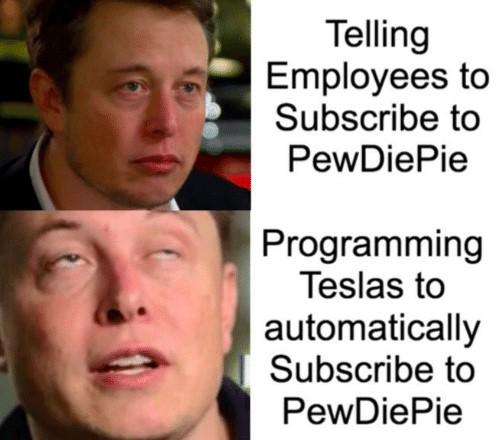
Figure 5: Meme of Elon Musk programming Teslas to support PewDiePie's channel
For a meme to become popular, it should meet certain criteria. Based on statistics, people tend to engage more with shorter, more concise texts and videos (Ayres, 2019; Cooper, 2020).
Additionally, according to author Jonah Berger (2013), people who experience high-arousal emotions, whether it is positive or negative, are more likely to share their experience and connect with others. Memes, in this case, are content that strongly arouses positive emotions, making it easier for people to engage with and to share it at a higher frequency.
Finally, as memes tend to go in style and become irrelevant fairly quickly, timing is an important criterion meme marketers must meet (Lechner, 2020).
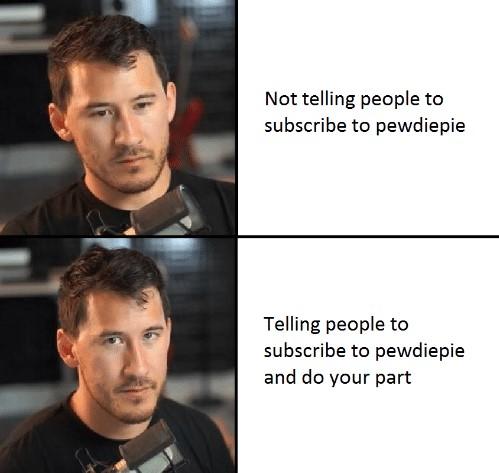
Figure 6: Meme of Markiplier approving of people supporting PewDiePie and doing their part
Senior strategist at We Are Social, Zanna Wharfe, states that memes are becoming the main form of native advertising and distribution platform, attributing its success to the look, feel, and humour of memes rather than the authority of influencers (Southern, 2018). Therefore, meme marketing is an effective advertising strategy for influencers, proving more efficient in attaining attention than the mere authority of being famous.
For influencers to enjoy the benefits of meme marketing, balancing promotion and relatability is vital. Much like García Rapp and Roca-Cuberes's (2017) criteria for an authentic influencer, meme marketing success for an influencer relies on the balance of presenting a positive, relatable image of the influencer while still being worthy of emulation. Lechner (2020) calls this "culture hacking" in which meme marketers must be aware of this balance, their audience, what's trendy, and the right timing for success. An example of this is Logan Paul giving his support to PewDiePie via a meme of his head photoshopped onto an iconic scene from the 2006 movie, 300, as soon as the meme started gaining notoriety.
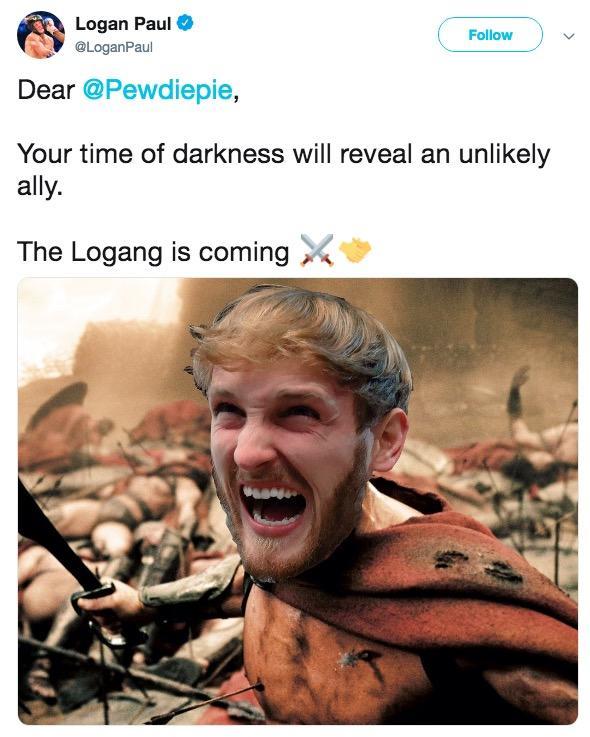
Figure 7: Logan Paul tweets a meme about his support for PewDiePie
Meme marketing is becoming attractive for brand sellers because of memes’ ability to go viral, thus increasing traffic and profit. It also gives brand sellers the chance to engage with younger consumers on a much smaller budget as memes are easy and cost almost nothing to make (Carr, 2020). However, meme marketing may not be practical for brands that strive for a more serious quality in the market because the use of memes relies on the context of a seller’s industry (Lechner, 2020).
According to Lyu (2020), the effectiveness of meme marketing for an influencer lies in their authenticity. She states that an influencer’s personality (as long as it’s entertaining) resembles the essence of memes that captivates audiences, thus giving the influencer relevancy. Furthermore, Lyu states that an influencer becoming popular through memes can be likened to traditional celebrities because of the memes helping audiences familiarise themselves with the influencer.
By late 2018, big-name brands had joined YouTube to share their content on a more accessible platform, but this came at the expense of independent creators
In this case, PewDiePie’s boost in popularity can be credited to the memes that people made about the subscription competition and the fact that he himself participated in the meme culture by making diss tracks and frequently featuring memes about it on his channel. His boost in popularity can be seen in the video below, where it details that in November 2018, he was 700K subscribers ahead of T-Series thanks to his supporters.
As many social media influencers would, PewDiePie monopolised on the memes, whether ironically or not, to boost the popularity of his channel. He made two diss tracks on T-Series: "Bitch Lasagna" with over 277M views and "Congratulations" with over 204M views. He also made a reaction video to the Asian Boss video on his subscription competition with T-Series and the claims that he’s racist towards Indians. Additionally, he invited a kid, who the fanbase calls "Blue Shirt Kid", who was featured on the video to host Meme Review on his channel.
“Ay, congratulations to your corporation”
PewDiePie ultimately lost to T-Series when the latter hit 100 million subscribers on 29 May 2019, much to the chagrin of his fans.
In conclusion, regardless of who hit 100M subscribers first, the statistics that show PewDiePie's channel growth indicate that meme marketing—done by PewDiePie, his fellow influencers, and his supporters—around the subscription competition contributed a lot to his channel growth. This success is clearly displayed in November 2018, when PewDiePie managed to overtake T-Series in subscriber count by 700K. By November 2018, PewDiePie had already released his diss track "Bitch Lasagna", which was one of his first contributions to the "Subscribe to PewDiePie" meme, and featured many memes about it on his Reddit reaction series "LWIAY". This gave more attention to the competition between him and T-Series. This seems to show that memes do, in fact, have an influence on who people subscribe to on YouTube and the biases they may have online.
Part of the reason PewDiePie had garnered so much support from both his fans and fellow independent creators is because of his status as a social media influencer. By late 2018, big-name brands had joined YouTube to share their content on a more accessible platform, but this came at the expense of independent creators having to compete with them and losing much of their revenue. Independent creators flocked to support PewDiePie to maintain the integrity of the more authentic community of independent creators on YouTube. Furthermore, fans of influencers supported PewDiePie as corporations did not meet the criteria that make an individual compelling and authentic in the digital world, of which one is the dialogic relationship an influencer has with their audience. These criteria were outlined by García Rapp and Roca-Cuberes (2017) and Cunningham and Craig (2017). This is attractive to fans because it gives them the opportunity to give feedback and to feel included in the production of content.
Finally, it is relevant and critical to ask: if memes are compelling enough to influence people's views in this conflict, who's to say that it won't influence other views that could trigger political friction or racial intolerance? Additionally, I believe that it is important to support independent creators. While meme marketing along with an influencer's authenticity is a robust means of gaining success, it is nothing without the support of fans and followers.
References
Alexander, J. (2019a, March 31). PewDiePie concedes to T-Series in battle for YouTube’s biggest channel. Retrieved January 9, 2021.
Alexander, J. (2019b, April 5). The golden age of YouTube is over. Retrieved January 8, 2021.
Alexander, J. (2019c, April 28). PewDiePie addresses New Zealand shooting, ends “Subscribe to PewDiePie” meme. Retrieved January 9, 2021.
Banet-Weiser, S. (2012). AuthenticTM: The Politics of Ambivalence in a Brand Culture. New York City, New York: NYU Press.
Carr, S. (2020, December 14). Meme Marketing Examples - The Future of Social Media Marketing? Retrieved January 8, 2021.
Cunningham, S., & Craig, D. (2017). Being ‘really real’ on YouTube: authenticity, community and brand culture in social media entertainment. Media International Australia, 164(1), 71–81. https://doi.org/10.1177/1329878x17709098
Do Indians Find PewDiePie’s Music Videos “Racist”? | ASIAN BOSS. (2019, May 4). [Video file]. Retrieved from https://www.youtube.com/watch?v=G5iNamnG3f0
Ending the Subscribe to Pewdiepie Meme. (2019, April 28). [Video file]. Retrieved from https://www.youtube.com/watch?v=Ah5MYGQBYRo
García-Rapp, F., & Roca-Cuberes, C. (2017). Being an online celebrity: Norms and expectations of YouTube’s beauty community. First Monday, 1. https://doi.org/10.5210/fm.v22i7.7788
Green, H. (2018, June 15). The $1,000 CPM. Retrieved January 10, 2021.
Hernandez, P. (2018, August 30). Pewdiepie’s reign as the biggest YouTube channel may soon be over. Retrieved January 8, 2021.
History of PewDiePie vs T-Series Visualized (Sept 2018 - Feb 2019). (2019, February 18). [Video file]. Retrieved from https://www.youtube.com/watch?v=zea8Xc54tWc
How long will I keep doing Youtube? QnA. (2018, October 21). [Video file]. Retrieved from https://www.youtube.com/watch?v=ggsqvFsgoKk
How the Marvel Avengers Series Ends (SPOILERS) leak [MEME REVIEW] 👏 👏#53. (2019, March 27). [Video file]. Retrieved from https://www.youtube.com/watch?v=tIZLzoqTToc
Keem, D. (2019, February 4). Keemstar on MrBeast and his friends at the Super Bowl wearing “Sub 2 PewDiePie” shirts [Tweet]. Retrieved from https://twitter.com/KEEMSTAR/status/1092212886867505153
Lechner, I. (2020, April 13). Meme Marketing: The Next Generation of Advertising - Magic Media. Retrieved January 8, 2021.
Lyu, M. (2020, September). Memes, Meme Marketing, and How Brands and Influencers Can Leverage Them on Social Media (Thesis). University of Southern California. Retrieved from http://cdm15799.contentdm.oclc.org/cdm/ref/collection/p15799coll89/id/37...
Paul, L. (2018, December 5). Logan Paul on PewDiePie vs T-Series [Tweet]. Retrieved from https://twitter.com/LoganPaul/status/1070448713187778560?s=20
PewDiePie vs T-Series Visualized Part 2 (Feb 2019 - Apr 2019). (2019, April 5). [Video file]. Retrieved from https://www.youtube.com/watch?v=ljudj4INcU0
PewDiePie, Roomie & Boyinaband – Congratulations. (2019, March 31). Retrieved January 8, 2021, from https://genius.com/Pewdiepie-roomie-and-boyinaband-congratulations-lyrics
Reclaim the Net. (2019, December 8). Corporations are taking over YouTube, 72% of the top 100 channels are now brands or mainstream celebs. Retrieved January 8, 2021.
Roose, K. (2020, August 27). A Mass Murder of, and for, the Internet. The New York Times. Retrieved January 9, 2021.
Shifman, L. (2013). Memes in a Digital World: Reconciling with a Conceptual Troublemaker. Journal of Computer-Mediated Communication, 18(3), 362–377. https://doi.org/10.1111/jcc4.12013
Stokel-Walker, C. (2020, March 12). It's the beginning of the end for independent YouTubers. OneZero. Retrieved January 8, 2021.
What do Indians think of Tseries vs Pewdiepie? (2019, March 9). [Video file]. Retrieved from https://www.youtube.com/watch?v=qov0ypksviU
What Indians Think Of PewDiePie vs T-Series [Street Interview] | ASIAN BOSS. (2019, March 5). [Video file]. Retrieved from https://www.youtube.com/watch?v=L3L4RMxrzyw